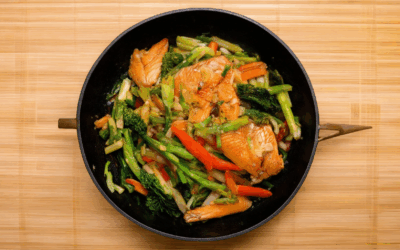Discover the culinary magic of combining fresh tuna with zesty lemon and aromatic garlic to create flavorful dishes that delight your senses. Whether you’re a seafood enthusiast or a home cooking pro, Lemon Garlic Tuna offers a versatile base for a wide range of recipes. From hearty pasta dishes to tender baked steaks, this combination of vibrant flavors enhances the natural richness of tuna, turning it into a nutritious and satisfying meal. Explore the health benefits of lemon and garlic, which not only elevate the taste of tuna but also support overall well-being. Dive into this ultimate guide to learn expert tips, variations, and step-by-step instructions for creating mouthwatering Lemon Garlic Tuna dishes. Perfect for quick weeknight meals or elegant dinner parties, these recipes promise to impress both your family and guests. With a focus on simplicity and flavor, this guide ensures you’ll never look at tuna the same way again.
Key Takeaways
– Lemon Enhances Flavor: Lemon adds brightness and acidity, complementing the rich taste of tuna steak.
– Versatile Use of Lemon: From caper sauce to marinades, lemon works as a versatile ingredient for tuna steak.
– Tasty Seasonings: Options like garlic, lemon, and herbs; spicy rubs; citrus and dill; and blackening seasoning offer varied flavor profiles.
– Health Considerations: Tuna steak’s mercury content requires caution, especially for vulnerable groups, and allergies may occur.
– Safe Consumption: Always cook tuna steak safely and avoid raw consumption for high-risk individuals.

Does Tuna Go with Lemon?
Tuna is a versatile fish that pairs exceptionally well with lemon, creating a bright and tangy flavor profile that enhances both seafood and other ingredients. Here’s why tuna and lemon make a fantastic combination:
- Flavor Enhancement : Lemon adds a refreshing acidity to tuna, balancing its richness and bringing out its natural sweetness.
- Marinades and Dressings : Lemon juice is a common ingredient in tuna marinades, helping to tenderize the fish while adding depth.
- Healthy Option : Lemon is rich in vitamin C, making it a nutritious addition to tuna salads or dishes.
Tuna and Lemon Recipe Idea:
For a quick and delicious meal, try our Lemon Herb Tuna Salad :- Mix chopped tuna with diced red onion, celery, capers, and a zesty lemon vinaigrette.- Top with fresh parsley and serve over crisp greens.
This dish is not only flavorful but also a great option for meal prep, keeping you fueled throughout the week.
Looking for more tuna inspiration? Explore our tuna salad recipe and discover how to elevate your seafood meals with lemon.
What Do Garlic and Lemon Do for You?
Garlic and lemon are not only delicious ingredients in cooking but also offer numerous health benefits when consumed together. Here’s a breakdown of their combined effects:
- Heart Health Support: Garlic contains allicin, a compound that may help lower cholesterol and improve blood flow, reducing the risk of heart disease. Lemon’s vitamin C content can aid in reducing inflammation, further supporting cardiovascular health.
- Antioxidant Benefits: Garlic is rich in sulfur compounds, acting as a powerful antioxidant that combats oxidative stress. Vitamin C in lemon enhances immune function and protects cells from damage.
- Blood Pressure Management: Both garlic and lemon have been shown to contribute to healthier blood pressure levels due to their combined effects on reducing inflammation and improving circulation.
- Digestive Aid: Lemon’s acidity may help stimulate digestion, aiding in the absorption of garlic’s nutrients. However, it’s essential to consume them in moderation to avoid discomfort.
- Immune System Boost: Vitamin C from lemon strengthens the immune system, while garlic’s compounds support overall health and wellness.
For optimal benefits, pair raw garlic with lemon juice, as this combination enhances the absorption of garlic’s active compounds. Remember to consume in moderation and consult a healthcare professional if you’re on medication, as lemon can interact with certain drugs.

Why Do People Put Lemon Juice in Tuna?
Lemon juice is often added to tuna for several reasons, primarily to enhance its flavor and texture. Here are the key reasons:
- Flavor Enhancement: The acidity of lemon juice balances the richness of tuna, making it taste brighter and more refreshing.
- Textural Adjustment: It can help soften the texture of canned tuna, making it creamier and easier to mix with other ingredients.
- Nutritional Benefits: Lemon juice contains vitamin C, which contributes to overall health and may enhance the nutritional profile of the dish.
- Color Enhancement: It can make the tuna appear fresher and more appealing by adjusting its color slightly.
This practice is particularly popular in tuna salads, where a squeeze of lemon juice is often a standard ingredient to elevate the dish’s taste and freshness.

Does Lemon Pair Well with Tuna Steak?
Yes, lemon pairs exceptionally well with tuna steak, enhancing its flavor profile through acidity and brightness. Here’s how you can effectively integrate lemon into your tuna steak dish:
- Lemon Caper Sauce : A classic combination, lemon caper sauce adds a tangy balance to the rich tuna, complementing its umami notes. This simple sauce can be prepared with fresh lemon juice, capers, olive oil, garlic, and parsley.
- Marinades and Rubs : Incorporate lemon zest and juice into your marinade for tuna steak. This not only tenderizes the meat but also imparts a refreshing citrus flavor, making the dish more vibrant.
- Drizzle Overcooked Steaks : After grilling or pan-searing your tuna steak, drizzle a mixture of lemon juice and olive oil for a zesty finishing touch. This enhances the natural sweetness of the tuna.
- Sides and Garnishes : Serve lemon-dressed greens or citrus-infused vegetables alongside your tuna steak for a balanced meal. Lemon segments or wedges can also add a colorful and refreshing element to the plate.
- Alternative Preparations : Experiment with lemon-based sauces like aioli or remoulade for a twist. These additions can elevate your tuna steak to new levels of flavor complexity.
For more creative recipes and pairing ideas, explore our collection of tuna steak dishes at Only Fish Recipes .
Best Seasoning for Tuna Steaks
The best seasoning for tuna steaks depends on your preferred flavor profile. Here’s a breakdown of popular options:
- Garlic, Lemon, and Herbs: A classic combination featuring minced garlic, lemon zest, dried thyme, and fresh parsley. This option enhances the natural flavor of the tuna with a bright, tangy taste.
- Spicy Rub: Combine 1 teaspoon of olive oil with 1 tablespoon of chili flakes, 1 teaspoon of smoked paprika, and 1 teaspoon of dried oregano. This spicy rub adds a kick of heat to the tuna steaks.
- Citrus and Dill: Mix equal parts fresh dill, grated lime zest, and a drizzle of honey. This refreshing seasoning pairs well with the richness of tuna.
- Blackening Seasoning: A popular choice for steak, this blend includes 1 teaspoon of paprika, 1 teaspoon of garlic powder, 1 teaspoon of onion powder, and a pinch of cayenne pepper. It creates a flavorful crust on the outside while leaving the center rare and juicy.
For the best results, apply the seasoning generously, patting it onto the surface of the tuna steaks. Let the mixture sit on the meat for about 15 minutes before cooking to allow the flavors to meld. Pair with a side of roasted vegetables or a crisp salad for a balanced meal.
Looking for more ideas? Explore our complete guide to seafood seasonings for inspiration and expert tips on enhancing your tuna dishes.

When Not to Eat Tuna Steak
Tuna steak, while a nutritious option, may not be suitable for everyone under certain circumstances. Here are key considerations:
- Mercury Content: Tuna, particularly larger species like bigeye tuna, contains higher levels of mercury. Consuming too much can lead to mercury poisoning, which can cause severe health issues. Pregnant women, breastfeeding mothers, and young children should limit their intake of tuna and other high-mercury fish.
- Allergies: Some individuals may have allergies to fish, including tuna. If you experience symptoms like swelling, itching, or difficulty breathing after eating tuna, seek medical attention immediately.
- Personal Preferences: While generally safe, some people may dislike the texture or flavor of tuna steak. Others may prefer it cooked differently or as part of a specific dish.
For most healthy individuals, eating tuna steak in moderation is perfectly fine. However, always cook and consume it safely, especially if you’re following a pregnancy or breastfeeding plan. Check with your healthcare provider for personalized advice.
Conclusion: Avoid eating raw tuna steak if you fall into a high-risk group or have specific health concerns. Opt for cooked versions and consult health guidelines for safe consumption.




0 Comments